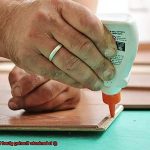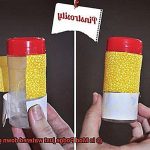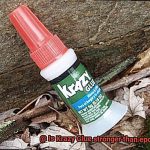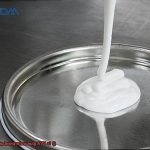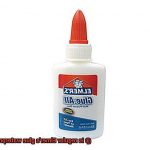Are you tired of your DIY projects getting ruined by water damage and leaks? Fear not, because PVA glue might just be your new best friend. Polyvinyl acetate, or PVA, glue is a versatile adhesive that’s perfect for woodworking, paper crafts, and even fabric projects. But the million-dollar question remains: is PVA waterproof when cured?
The answer isn’t as simple as a yes or no. While PVA glue can resist dampness and humidity in the air, it’s not designed to withstand being submerged in water for extended periods. However, some types of PVA glue are formulated with water-resistant additives that make them waterproof when cured. These glues go by names like “water-resistant PVA glue” or “PVA+ glue.”
But here’s the kicker: how you apply the PVA glue can also impact its water-resistance. If you apply multiple thin layers of the adhesive, it’ll penetrate deeper into the material and create stronger adhesion. This leads to better water-resistance when cured.
So what does this mean for your DIY projects? It means that understanding the water-resistance properties of PVA glue can help you pick the right adhesive for your project and prevent any unwanted water damage. Whether you’re building an outdoor birdhouse or creating a scrapbook, make sure to consider the water-resistance of your PVA glue before diving in headfirst.
What is PVA Glue?
Contents
Whether you’re a seasoned DIY enthusiast or a professional woodworker, PVA glue is a staple in your crafting arsenal. But what exactly is PVA glue, and why is it so popular? Let’s dive into the world of this versatile adhesive.
PVA glue, or polyvinyl acetate glue, is a type of adhesive that can bond a wide range of materials, including porous surfaces like wood and paper, as well as non-porous surfaces like plastic and metal. It comes in both white and clear varieties, with the white version being more common. You can find it in squeezable bottles or larger containers for use with brushes or rollers.
One of the key benefits of PVA glue is its clear-drying formula, making it ideal for use on projects where the glue may be visible. Plus, it dries relatively quickly, allowing you to continue working on your project without having to wait too long for the glue to set.
But what about its waterproofing ability? It’s not a simple yes or no answer. PVA glue is water-resistant when dry, meaning it can withstand slight exposure to moisture without losing its adhesive properties. However, prolonged exposure to water or moisture can weaken its bond.
The waterproofing ability of PVA glue depends on various factors, such as its formulation and application process. Some PVA glues have additives that make them more resistant to water than others. The thickness of the glue layer and the surface it is applied on can also affect its waterproofing ability.
Proper surface preparation and curing time are also critical factors in ensuring a strong bond that can withstand water exposure. If the surface is not thoroughly cleaned and dried before applying the glue, it may not adhere correctly and lose its bond when exposed to water. Similarly, insufficient curing time can result in weak adhesion that cannot withstand water exposure.
Is PVA Glue Waterproof When Cured?
When it comes to adhesives, PVA glue is a popular choice for a variety of applications, including woodworking, paper crafts, and fabric arts. However, one of the most common questions asked about this glue is whether it is waterproof when cured.
So, is PVA glue waterproof when cured? In short, no. While it can tolerate some exposure to water, it will eventually lose its bond strength and break down if submerged or exposed to moisture for prolonged periods. But don’t lose hope just yet – there are ways to increase PVA glue’s water resistance.
To start, consider using a specialized version of PVA glue that is designed to be more resistant to water. Brands such as Titebond offer “exterior” or “weatherproof” varieties that can better withstand exposure to the elements.
It’s also important to allow enough time for the glue to fully cure before exposing it to moisture. Rushing the curing process can weaken the bond strength and make it more susceptible to water damage. So be patient and allow ample drying time.
But even with these measures, it’s still not recommended to fully submerge items glued with PVA glue in water, such as wooden boats or outdoor furniture. Instead, opt for a marine-grade adhesive specifically designed for watercraft or outdoor use.
Factors That Affect the Waterproofing Ability of PVA Glue
PVA glue, also known as polyvinyl acetate, is a popular adhesive that can be used for various applications such as woodworking, paper crafts, and more. However, when it comes to waterproofing, the answer is not as straightforward as one might think. Several factors can affect the waterproofing ability of PVA glue, and it’s essential to understand them to achieve the best results.
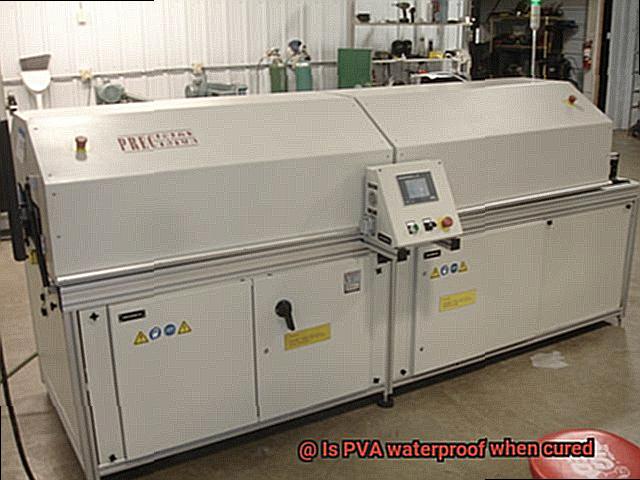
Firstly, the quality of the PVA glue used matters significantly when it comes to its water resistance. Cheaper or lower quality glues may not be as waterproof as higher quality brands. Therefore, investing in a good quality adhesive is crucial if you want to ensure its waterproofing ability.
Another factor that can affect its waterproofing ability is the surface on which it’s applied. PVA glue works best on porous surfaces such as wood and paper where it can penetrate and create a strong bond. However, non-porous surfaces like plastic or metal may not adhere well, leading to less water resistance.
The application method can also impact the waterproofing ability of PVA glue. Applying too thin or uneven layers of glue may not create a strong enough bond to withstand exposure to water. Similarly, applying glue in a humid environment or at low temperatures can lead to improper drying and reduce its water resistance.
Lastly, allowing sufficient time for the glue to cure fully before exposure to water is crucial. PVA glue typically takes around 24 hours to achieve its maximum strength and become fully water-resistant. If exposed to water before it has cured entirely, the glue may not withstand moisture well.
To achieve maximum waterproofing ability, high-quality PVA glue should be used, applied evenly on porous surfaces, allowed ample drying time, and avoiding exposure to water before curing. By following these guidelines, you can increase the waterproofing ability of PVA glue and ensure a strong bond for your project.
Formulation and Application Process
Look no further than PVA glue – a versatile adhesive used in woodworking, paper crafts, and other applications. However, did you know that the formulation and application process of PVA glue can determine its water resistance when cured?
Let’s start with the formulation of PVA glue. It’s important to note that different manufacturers may have unique formulations for their products. Some formulations may include additives to improve water resistance, while others may not. If you require a PVA glue that is waterproof when cured, it’s essential to check the label or contact the manufacturer for specific information on a particular product’s water resistance.
Next up is the application process. Following the manufacturer’s instructions carefully is key when using PVA glue. Generally, it should be applied in a thin layer and allowed to dry completely before adding any additional layers. Additionally, it’s crucial to apply enough pressure during the bonding process to ensure a strong bond.
While some PVA glues claim to be waterproof when cured, it’s essential to remember that they may still break down over time with prolonged exposure to moisture. Therefore, choosing the right product for your intended use and following proper application techniques are critical for achieving maximum water resistance.
Surface Preparation and Curing Time
Look no further than PVA glue. But before you start slathering it on, it’s crucial to understand the importance of surface preparation and curing time.
Proper surface preparation is the foundation for a strong bond. It involves more than just wiping down your project with a damp cloth. You need to ensure that the surfaces are completely clean, dry, and free from any oil, debris, or dust. Think of it like trying to stick two pieces of tape together – if there’s any dirt or dust between them, they won’t stick properly. The same goes for PVA glue.
Once you’ve prepped the surface, give it time to dry fully. Moisture can affect the bonding process and weaken the bond. You don’t want your project falling apart because you didn’t wait long enough for the surface to dry.
Then comes the crucial step of allowing enough time for the glue to cure fully. Don’t rush this step – it’s what gives your project its waterproofing capabilities and ensures that it lasts. The curing time varies depending on factors such as temperature and humidity, so make sure to check the label or contact the manufacturer for guidance. And keep in mind that some types of PVA glue have shorter curing times than others.
Here are some tips to help you get the most out of your PVA glue:
- Clean the surfaces thoroughly with a damp cloth and let them dry completely.
- Apply the glue evenly and avoid using too much.
- Allow sufficient drying time before applying another coat or handling the project.
- Be patient and give the glue enough time to cure fully before exposing it to water or other elements.

Advantages of Using PVA Glue
Its advantages are numerous, making it a go-to choice for professionals and hobbyists alike.
One of the most significant benefits of PVA glue is its water-solubility. Unlike other adhesives that require harsh chemicals or solvents to clean up, PVA glue can be easily wiped away with a damp cloth. Not only does this make it convenient to use, but it also makes clean-up a breeze.
Another advantage of PVA glue is its clear drying properties. This feature is especially beneficial for projects where appearance is important. You won’t have to worry about any unattractive residue or marks left behind after the glue dries. The transparency allows it to blend seamlessly with the surrounding material, creating a polished and professional finish.
PVA glue is also incredibly versatile, making it an ideal choice for those who work with multiple materials such as paper, cardboard, wood, and fabric. This attribute makes it a favorite among crafters and DIY enthusiasts who require an adhesive that can handle different surfaces.
Finally, PVA glue is non-toxic and safe to use around children. Its lack of hazardous chemicals or harmful fumes makes it an ideal adhesive for school projects and crafts that involve little ones.
Disadvantages of Using PVA Glue
It’s easy to use, versatile, and safe for kids. However, despite its many benefits, there are some disadvantages to using PVA glue that must be considered.
One of the most significant drawbacks of PVA glue is its lack of complete waterproofing. While it can resist water to some degree, prolonged exposure to moisture or water immersion can cause it to fail. This means that if you’re planning on using PVA glue for outdoor projects or items that will come into contact with water frequently, it may not be the best adhesive choice.
Another disadvantage of PVA glue is its clear finish when dried. While this may be desirable for some projects, it can be problematic if you require a specific color or finish. If this is the case, you may want to explore using alternative adhesives that dry in the desired color or finish.
In addition to these issues, PVA glue also has a limited shelf life. Once opened, the glue can dry out rapidly, rendering it unusable. This means that unless you use the entire bottle within a short period of time, you may end up wasting your money.
Finally, dried PVA glue can be challenging to remove and often requires harsh chemicals or sandpaper. This removal process can damage the surface of your item or even pose a safety hazard if not handled correctly.
V_0eIsgg2pc” >
Conclusion
In summary, PVA glue is a jack-of-all-trades adhesive that can be used for a plethora of applications ranging from woodworking to paper crafts to fabric projects. Although it may not be completely waterproof when cured, it does have the ability to repel moisture and humidity in the air to some extent. However, if exposed to water or moisture for extended periods of time, its bond strength may weaken.
To enhance its water resistance capabilities, you can opt for specialized versions of PVA glue that are specifically designed to withstand water or apply multiple thin layers of adhesive for deeper penetration into the material and stronger adhesion. Proper surface preparation and curing time are also crucial factors in ensuring a robust bond that can endure water exposure.
PVA glue has several advantages such as clear drying properties, versatility, and non-toxicity. However, there are also some disadvantages to consider such as limited shelf life and difficulty in removing dried glue.
In conclusion, comprehending the water-resistance properties of PVA glue is imperative when selecting an adhesive for your project and preventing unwanted water damage.


